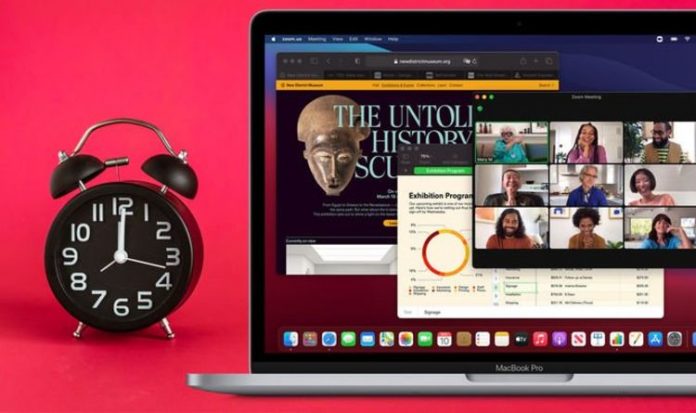Apple held its latest product showcase earlier this week, where the Californian company unveiled an upgraded MacBook Air, MacBook Pro, and Mac Mini powered by its a custom-designed processors, dubbed Apple M1, for the first time. It also used the event, which was teased with the tagline “One More Thing” – a reference to Apple co-founder Steve Jobs’ trademark announcements at the tail-end of the company keynotes, to confirm when the latest version of its desktop operating system, macOS 11 Big Sur, will be available.
Starting today, the new operating system will roll-out to MacBook Air, MacBook Pro, Mac Mini, Mac Pro, iMac and iMac Pro owners. The next-generation version of macOS will show up in the Software Update section of the main Apple menu, which can be accessed from the logo in the top left-hand corner of your screen. In previous versions of macOS, the latest upgrade launched in the App Store, but this is no longer the case.
macOS 11 Big Sir will be available Thursday November 12, Apple confirmed during the keynote presentation, which was pre-recorded in its Californian headquarters due to the ongoing public health crisis gripping the United States and large swathes of the rest of the world. Apple didn’t confirm an exact time for the operating system launch, however, in previous years, the update has typically started to come online around 6pm GMT.
However, that’s not a schedule confirmed by Apple. In fact, when iOS 14 started to roll out back in September, the smartphone software didn’t start to appear for users until almost 9pm – leading to thousands of confused iPhone owners flooding social media with complaints about a “problem” with the update or “last-minute delays”. None of this was confirmed by Apple and as the Cupertino-based company had never officially confirmed a release time, it’s still unknown whether the update launched precisely on time, or whether there were issues that delayed the roll out by a few hours.
Regardless, we’d expect to start seeing macOS 11 Big Sur arrive on some machines in the early evening, so keep checking the Apple menu on your Mac if you want to be one of the first.
If you missed the initial reveal of macOS Big Sur during the annual Worldwide Developers Conference, then boy! you’ve got a lot to catch-up on. Apple has completely overhauled the design of the operating system, bringing in new elements from iOS and iPadOS – like the standardised rounded-square app icons, grouped notifications and redesigned widgets – as well as a number of new features specific to the desktop.
In terms of design, Apple has added a truckload of translucency across the operating system. Full-height sidebars have been added to application and Finder windows that allow colours from the windowed app, or desktop background, behind to subtly bleed through. The menu bar at the top of the screen is almost completely transparent in macOS Big Sur so that, according to Apple, “your content is always front and centre”.
iPhone and iPad owners will be familiar with the Control Centre – a menu of frequently-used settings that can be accessed by swiping down from the top right-hand corner of their screen. With Big Sur, Apple has added the same feature to the Mac for the first time. Accessed by clicking on an icon in the menu bar, the drop-down includes controls you use most often, like Wi-Fi and Bluetooth toggles, as well as controls to play music and enable Dark Mode for your display. Unlike iOS, the new Control Centre on macOS lets you add controls and drag favourites to the menu bar to access even faster.
Big Sur includes a reworked Messages app with the ability to reply to individual messages in a thread, receive notifications when your name is mentioned in a group chat, react with Memoji, send GIFs and more. Maps has also been upgraded with much greater detail as well as cycling directions, which can be beamed to your iPhone before you set out on a journey.
Music has been redesigned to match the recent updates on iPhone and iPad, including a new Listen Now tab with artist interviews, new releases and updated playlists from the team of editors, to replace the For You section found in previous releases. Apple Photos gains an improved one-tap-and-you’re-done Retouch tool powered by machine learning as well as new granular editing controls.
Apple says that work behind-the-scenes ensures that, once you’re running macOS Big Sur, future operating system updates will be much faster. The iPhone maker states, “software updates begin in the background and finish faster than before – so it’s easier than ever to keep your Mac up to date and secure.”
So, who will be able to download and install macOS Big Sur?
Chances are, if you bought a Mac in the last few years, you’ll have no worries upgrading to macOS Big Sur. And despite the operating system being developed to take advantage of the new Apple custom-designed M1 chipset in the latest MacBook Air, MacBook Pro and Mac Mini, a huge number of Intel-powered Macs will benefit from the same redesign and features this evening.
That said, some Macs capable of running macOS Catalina – the previous version of the operating system – will be unable to make the move to Big Sur.
macOS 11 Big Sur is compatible with…
- Apple MacBook | 2015 and newer
- MacBook Air | 2013 and newer
- MacBook Pro | “Late 2013” model and newer
- iMac | 2014 and newer
- iMac Pro | 2017 and newer
- Mac Mini | 2014 and newer
- Mac Pro | 2013 and newer
The following Macs, which are currently able to run macOS Catalina, will not be able to upgrade to the next version of macOS…
- MacBook Pro | 2012 and “Early 2013” models
- MacBook Air | All 2012 models
- iMac | 2012 and 2013 models
- Mac Mini | All 2012 models




